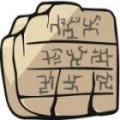
Worksheets and No Prep Teaching Resources
Reading Comprehension Worksheets
History of Books and Writing

History of Books and Writing
 Worksheets and No Prep Teaching Resources Reading Comprehension Worksheets History of Books and Writing |
 History of Books and Writing |
| edHelper's suggested reading level: | grades 9 to 12 | |
| Flesch-Kincaid grade level: | 8.01 |
|
Slips of Salvation and Other Printed Miracles
By Colleen Messina |

|
 1 For centuries, books were copied by hand, which was tedious and tiring. The poor, cold monks had sore backs and headaches, and they couldn't keep up with the demand for their beautiful manuscripts. After all, it took one monk twenty years to transcribe a single Bible! The monks sometimes encased the precious books in metal covers and chained them to church walls to keep them safe. Everyone wanted more books, but no one could figure out how to do it. Then a creative German named Johannes Gutenberg said to himself, "There has to be a better way," and invented the printing press.
1 For centuries, books were copied by hand, which was tedious and tiring. The poor, cold monks had sore backs and headaches, and they couldn't keep up with the demand for their beautiful manuscripts. After all, it took one monk twenty years to transcribe a single Bible! The monks sometimes encased the precious books in metal covers and chained them to church walls to keep them safe. Everyone wanted more books, but no one could figure out how to do it. Then a creative German named Johannes Gutenberg said to himself, "There has to be a better way," and invented the printing press. |
Create Weekly Reading Books
Prepare for an entire week at once! |
| Leave your feedback on Slips of Salvation and Other Printed Miracles (use this link if you found an error in the story) |
 |
History of Books and Writing
|
 |
High School Reading Comprehensions and High School Reading Lessons
|
 |
Social Studies
|